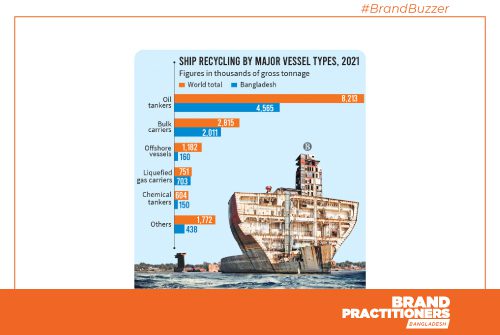Bangladesh has once again become the top ship recycling country with more than half of the world’s ships recycled here, according to a report of United Nations Conference on Trade and Development (Unctad).
In the 12 months to January 2022, Bangladesh recycled 8.02 million tonnage of ships accounting for 52.4% of the world total, of which nearly 57% were oil tankers, 25% bulk carriers and 9% liquefied gas carriers, said the report titled “Review of Maritime Transport 2022” published on 29 November.
At the same period of the previous year, around 54% of the world’s oil tankers, 18.4% of bulk carriers and about 5% of liquefied gas carriers were recycled in Bangladesh, reads the annual flagship report.
In 2021, Bangladesh with Pakistan, India, and Türkiye, accounted for 96% of the world’s ship recycling.
Bangladesh’s contributions to shipbreaking increased by around 20% in 2021 compared to the previous year, while the global shipbreaking amount declined by 12% to 15.3 million tonnage.
The report mentioned some factors responsible for the decline in global ship recycling volume such as limits on imports of vessels on letters of credit to protect foreign reserves in some countries including Bangladesh and Pakistan, and the Covid-19 restrictions.
Maritime trade to slow
According to the report, although the global maritime trade recovered in 2021, it faced a complex operating environment troubled with risk and uncertainty in 2022.
Freight rates reach historic highs
By early 2022, freight rates had already started to decline on some routes, and from mid-year, there was a drastic downturn.
Historically high and volatile freight rates, congestion, closed ports and new demands for shipping following the pandemic and the war in Ukraine have all had measurable impacts on people’s lives.
“We need to learn from the current supply chain crisis and prepare better for future challenges and transitions. This includes enhancing intermodal infrastructure, fleet renewal, and improving port performance and trade facilitation,” said Rebecca Grynspan, secretary general of Unctad.
The review estimates that higher grain prices and dry bulk freight rates in early 2022 contributed to a 1.2% increase in consumer food prices.
“Higher freight rates have led to surging consumer prices, especially for the most vulnerable. Interrupted supply chains led to lay-offs and food insecurity,” said Shamika N Sirimanne, director of Unctad’s technology and logistics division.













